 Marketing is simple:
Marketing is simple:
Create a product that people can stumble upon, obsess over, fall in love with, become addicted to and tell their friends about.
There ya go. I just saved your company $80,000 in marketing costs.
You’re welcome.
– – –
OK, so, maybe marketing isn’t THAT simple.
Today’s post is about how to make your website more findable, more obsessable, more lovable, more addictable and more spreadable. For each of these five attributes, we’ll explore one example, a few strategies and one exercise.
Let class begin…
1. BE FINDABLE. You need to create a Visibility Plan. Not a Marketing Plan. Not a Business Plan. A Visibility Plan. My immediate suggestions: Use Social Bookmarking tags. Blog every day. Tweet several times a day. Use Facebook strategically, not annoyingly. Post articles on www.ezinearticles.com regularly.
As far as SEO? Google Ad Words? Sponsored links? Sure. Go for it. Do what you have to do to get people to your site (unethical and illegal strategies notwithstanding). Remember, people can’t obsess over, fall in love with, become addicted to and tell their friends about something they can’t find.
EXAMPLE: I noticed an immediate increase in traffic, comments and outreach emails from readers of my blog the DAY I added the Share This Tool Bar at the end of each post.
Here’s how YOU can become more findable today:
a. Take every interview. It doesn’t matter if it’s USA Today, some blogger in Taiwan or a local high school journalism class. If somebody wants to interview you, your answer is, “What time is good for you?”
Interviews lead to more interviews. Interviews get traffic. Interviews are great practice talking about your product. Interviews instantly position you in a leadership role. Here’s a cool one I did with Dean Jackson the other day.
What’s more, sometimes your best interviews come from the most unlikely places. I know my best interview did. How many interviews have you turned down because the publication didn’t have the words, “New York Times” in the title?
b. Writing attracts traffic. Other than doing hundreds of interviews, my #1 source of traffic comes from writing. 1000+ blog posts. 700+ articles. 300+ tweets. That’s how people find me. LOTS of people.
As such, I’m one of the most googleicious writers on the web. And the best part is, each of the tentacles in my Octopus Marketing Strategy actually delivers solid, unique value. What did you write today? Is everything you know written down somewhere? And how many ideas did you lose last month because you said to yourself, “Eh, I’ll write it down later”?
EXERCISE: How did you “find” the last five websites YOU fell in love with? What were the exact steps that took you to those sites? Make a list, extract the commonalities and then emulate those attributes in your own business.
2. BE OBSESSABLE. The word “obsess” comes from the Latin obsidere, which means, “to occupy.” Hmm. Interesting. I wonder if all this blather about “hits” is a misnomer. Maybe “hits” don’t mean anything. Maybe “hits” is an acronym for “How Idiots Track Sales.”
Perhaps what’s more important is how LONG people stay on your site, if they come BACK regularly, and if they’re the RIGHT people. To quote Seth Godin from Meatball Sundae, “How many eyeballs isn’t as important as whose eyeballs.”
EXAMPLE: My girlfriend is a knitter. She spends at least an hour a day on
Ravelry. She’s obsessed with it. So, out of curiosity, I looked over her shoulder one night to see what this online knitting community was all about.
After only a few minutes, I GOT it. I realized why she obsessed over Ravelry. (Keep in mind – I couldn’t knit a stitch if a Yarn Terrorist was holding me up at needlepoint.) But still, I got it. I saw the light (er, fiber.) So, do yourself a favor. Just go to Ravelry and poke around. You’ll see what I mean. It’s quite obsessable.
Here’s how YOU can become more obsessable today:
a. Be a destination, not a website. A “website” is not going to get people to come TO, hang out AT and tell their friends ABOUT anything. It needs to be much more than just information. It needs to be interactive. It needs to be participative.
It needs to be updated regularly. It needs to be THEE source, THEE go-to-place, the El Dorado, The Mecca … for a certain kind of people who want a certain kind of thing. In short: A destination. Why would someone come to (and stay at) your website for more than 60 seconds? Why would someone return to your website consistently?
b. Make passion palpable. The more your website (er, destination) revolves around passion, the easier it is for you to win. And the easier it is for your visitors to win. The challenge is creating an interactive environment where healthy participation naturally emerges. An environment that enables, supports and rewards authentic dialogue.
That’s the best part. If you create the right kind of environment, the right atmosphere, the right space and the right energy, the people inside of it will take care of themselves. How does your website build community? How many of your customers are talking to each other?
EXERCISE: Which five websites are you obsessed with? Why? How did that obsession grow over time? Make a list, extract the commonalities and then emulate those attributes in your own business.
3. BE LOVABLE. Not cute or cuddly. Attractive. A dream-come-true for your particular niche, audience or customer. Something that when they arrive at the website, they think to themselves, “OMG. This is SO for me!” “Thank you Jesus!” and “Where have you BEEN all my life?”
Essentially, you need to be the answer to the following longing, which I’ve dubbed The Ultimate Dream Statement:
“I wish there was an (x) so I wouldn’t have to (y).”
EXAMPLE: Think about your iPod. You LOVE it, don’t you? Of course you do. Dude, I’m thinking about eloping to Tahoe with mine. (This is payback for my girlfriend’s love affair with her yarn.)
Anyway, I imagine that Steve Jobs was sitting around Apple one day thinking, “Man, I wish there was an easy way to compile all of my music onto a compact, digital storage device so I wouldn’t have to schlep 100 CD’s in my car, to work and on the plane!” 150 million iPods later, I’d say his idea was pretty lovable.
Here’s how YOU can become more lovable today:
a. Pleasure and pain. Those are the only human motivators that matter. Your challenge is to make people’s dreams come true while simultaneously helping them avoid something frustrating. I suggest doing a Google search for, “This site is awesome because,” and “I love this site.” See if you can’t find a few Top Ten Lists of highly lovable sites. Take notes. What sites do other people find lovable? How could your site mirror those qualities?
b. Free research. Listen to what people are complaining about. Do another a Google search for “I wish there was a,” and “so I wouldn’t have to.” You’ll find hundreds of blogs, message boards and forums, each of which will provide a window into the psyche of online buyers. Whom are you listening to? What do people need to hear to fall in love with you?
EXERCISE: Which five websites recently made you exclaim, “Dude, I LOVE this site!” Why? What about them, specifically AND generally, did you love? Make a list, extract the commonalities and then emulate those attributes in your own business.
4. BE ADDICTABLE. Think Heath Ledger in Brokeback Mountain. Think, “I can’t quit you!” That’s what you’re going for. People who can’t quit you. Because if you can get to that point, they’re no longer people. They’re fans. And they’re lightyears beyond “satisfied” or “loyal.” They’re INSISTENT.
EXAMPLE: I get emails about once a week from viewers of NametagTV that say, “I just spent the last two hours watching videos on your site!” or “I think I’ve seen every video you have!” And I’m thinking, “Good. Thank you. Glad you liked them. There’s more where that came from…”
Here’s how YOU can become more addictable today:
a. Update content regularly. Websites are like newspapers – nobody wants to read them if they’re two years old. (Thanks for that one, Greg Peters.) Whether it’s videos, pictures, music, articles or recipes, your need new content. Like, every day. If not every day then every week.
Remember: Familiar structures lead to mental laziness. As a result, people’s brains filter out unchanging backgrounds because, in their minds, there’s no need to pay attention. It’s called The Caveman Effect. Learn it. When was the lat time you refreshed YOUR content? Is your website a dinosaur?
b. Have depth. Don’t have a few videos or pictures here and there. Have dozens. Hundreds. Thousands! The more the better. The goal is to gently and respectfully suck people into your vortex of content so they lose track of time.
Think Vegas. Think Casinos. “No windows, no clocks.” Minus the mobsters, of course. When was the last time someone told you, “I just spend the last two hours on your site!”
EXERCISE: What five sites are you currently addicted to? How did you become addicted to them? And what still brings you back every day? Make a list, extract the commonalities and then emulate those attributes in your own business.
5. BE SPREADABLE. Businesses that get talked about GET more business. Period. And if people aren’t actively telling their friends about your website, it don’t exist. Period. So, the challenge isn’t to “go viral” or “get people to start talking about you,” bur rather, to create an environment in which WOM is most likely to occur.
EXAMPLE: Cake Wrecks is the single funniest blog I’ve ever read in my life. It makes my day, every day. I’m addicted to it, I’m obsessed with it, I love talking about it, and I’m (now) spreading the word about it. Oh, and did I mention Jen averages about 196 comments on each post? Holy Butter Cream Batman!
Here’s how YOU can become more spreadable today:
a. Make it Moo. Build remarkability into your ideas before they go public.
b. Free is key. If you want it to be viral, (some) of your content HAS to be free.
c. Images, not words. Stop lying to yourself. Nobody’s going to read all that copy. Write less. Hemingway said that shorter sentences win. They do.
d. Use RSS. It’s the best tool for building your permission asset.
e. Give fans megaphones. Find people that have big mouths, market to them and then get out of the way.
f. Simple. Simplicity is better, quicker, easier and most importantly, what customers crave.
EXERCISE: What are the last five sites you sent all your friends to, or blogged about? What motivated you to spread the word? And how did people respond once they took your recommendation? Make a list, extract the commonalities and then emulate those attributes in your own business.
– – –
NOTE: The secret to this whole process is remembering to listen.
And I mean REALLY listen.
So, any time people start telling you how they stumbled upon, why they obsess over, how they fell in love with, what makes them addicted to or how many friends they told about your site, STOP TALKING.
Write it down. Right then and there, right in front of them. Capture the exact words they say. It’s not only good market research; it also makes them feel essential, helpful and valued.
REMEMBER: Be findable. Be obsessable. Be lovable. Be addictable. Be spreadable.
That’s marketing in a nutshell.
Enjoy your $80,000!
LET ME ASK YA THIS…
Who’s finding, obsessing over, loving, addicted to and spreading the word about YOU?
LET ME SUGGEST THIS…
For the list called, “101 Ways to Create a Powerful Web Presence,” send an email to me, and I’ll send you the list for free!
* * * *
Scott Ginsberg
That Guy with the Nametag
Author, Speaker, Coach, Entrepreneur
[email protected]
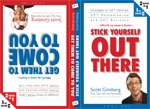 The world’s FIRST two-in-one, flip-flop book!
The world’s FIRST two-in-one, flip-flop book!
Buy Scott’s comprehensive marketing guidebook on Amazon.com and learn how to GET noticed, GET remembered and GET business!
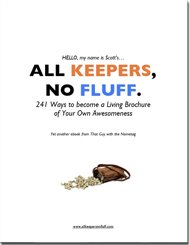 So, I wrote a new ebook last night.
So, I wrote a new ebook last night. Who’s quoting YOU?
Who’s quoting YOU?
 Your introduction is WAY too long.
Your introduction is WAY too long.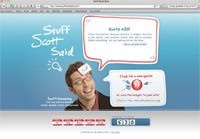 Who’s quoting YOU?
Who’s quoting YOU?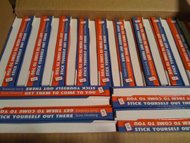 Great news!
Great news!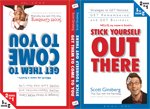 The world’s FIRST two-in-one, flip-flop book!
The world’s FIRST two-in-one, flip-flop book! The world’s FIRST two-in-one, flip-flop book!
The world’s FIRST two-in-one, flip-flop book! Three questions:
Three questions: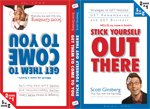 The world’s FIRST two-in-one, flip-flop book!
The world’s FIRST two-in-one, flip-flop book! BIG QUESTION: Are you afraid of the physical act of writing; or are you afraid of exposing your true self on the page and then being judged on it?
BIG QUESTION: Are you afraid of the physical act of writing; or are you afraid of exposing your true self on the page and then being judged on it?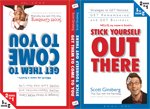 The world’s FIRST two-in-one, flip-flop book!
The world’s FIRST two-in-one, flip-flop book! Nope, it’s got nothing to do with Google.
Nope, it’s got nothing to do with Google.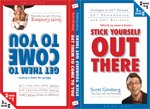 The world’s FIRST two-in-one, flip-flop book!
The world’s FIRST two-in-one, flip-flop book! Marketing is simple:
Marketing is simple: The world’s FIRST two-in-one, flip-flop book!
The world’s FIRST two-in-one, flip-flop book!
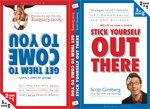 The world’s FIRST two-in-one, flip-flop book!
The world’s FIRST two-in-one, flip-flop book! As a Thought Leader, you need to be a master of your subject.
As a Thought Leader, you need to be a master of your subject. The world’s FIRST two-in-one, flip-flop book!
The world’s FIRST two-in-one, flip-flop book!